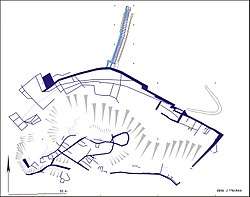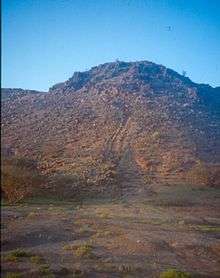Lizq
| لزق | |
 Plan of the Early Iron Age fort Lizq L1 | |
 Shown within Oman | |
| Location | Lizq, Ash Sharqiyah North Governorate, Oman |
|---|---|
| Region | Eastern Arabia |
| Coordinates | 22°41′52.5″N 58°10′58.75″E / 22.697917°N 58.1829861°E |
| Type | Fortification |
| Length | 110 m (360 ft) |
| Width | 170 m (560 ft) |
| Area | 2 ha (4.9 acres) |
| History | |
| Material | Stone |
| Founded | Early Iron Age |
| Periods | Iron Age |
| Satellite of | Lizq |
| Site notes | |
| Discovered | 1979 |
| Excavation dates | 1981 |
| Archaeologists | Stephan Kroll |
| Condition | Ruined |

Lizq is an archaeological site in Ash Sharqiyah, Oman. Located on a mountain lying in a plain, 1000 m south-east of the south-eastern edge of the Lizq palm garden, the fort dates to the Lizq-Rumaylah/Early Iron Age.
Description
The site was discovered in 1979, the result of the archaeological exploration of Gerd Weisgerber of the German Mining Museum (Deutsches Bergbau-Museum) in Bochum. Shaikh Hamdan al-Harthy of Samad led Weisgerber to the site.[1] In 1981 a single season long German archaeological team mapped and conducted minimal rescue excavation. They did an ad hoc restoration of the stairs which lead up the northern face of the mountain. Since there are several sites near Lizq town, the fort is disambiguated as 'L1'.
The Lizq fort owes its existence to the reliable occurrence of water at a natural causeway at the southern side of the central mountains. The main fort on the western mountain peak is some 175 m wide and has a surface of more than 20.000 m2 in surface area. This makes it the largest Early Iron Age fort in central Oman. The location of the Iron Age village associated with the fort remains unknown. No falaj was discovered.[2]
Important is Kroll's comparison of the pottery with that of Iron Age Iran. [3]
See also
Sources
References
- ↑ Stephan Kroll, Die Bergfestung Lizq-1, in: Gerd Weisgerber et al., Mehr als Kupfer in Oman, Der Anschnitt 33, 1981, 226-231. ISSN 0003-5238.
- ↑ Paul Yule, Cross-roads – Early and Late Iron Age South-eastern Arabia, Abhandlungen Deutsche Orient-Gesellschaft, vol. 30, Wiesbaden 2014, 31-34 Fig. 12.
- ↑ Kroll S. (1991). "Zu den Beziehungen eisenzeitlicher Keramikkomplexe in Oman und Iran". In Schippman, Klaus; Herling, Anja; Salles, Jean-François. Golf-Archäologie: Mesopotamien, Iran, Kuwait, Bahrain, Vereinigte Arabische Emirate und Oman. Internationale Archäologie (in German). 6. Buch am Erlbach: M.L. Leidorf. pp. 315–320. ISBN 9783924734244. OCLC 34928791.
- ↑ Nayeem, Mohammed (1996). Prehistory and protohistory of the Arabian peninsula.¬The¬ Sultanate of Oman. 4. Hyderabad: Hyderabad. pp. 221–222 fig. 25. ISBN 81-85492-06-9.
- ↑ Kroll, Stephan (1998). Mouton, M.; Carrez, F., eds. Assemblage céramiques des sites de l’Age du fer de la peninsula d’Oman. Documents d'archéologie de l'Arabie. Lyon: MAISON DE L'ORIENT MEDITERRANEEN. ISBN 2-903264-85-6.
- ↑ Potts, Daniel (1992). The Arabian Gulf in Antiquity. 1. Oxford: Clarendon. pp. 357, 373, 394, pl. xiia. ISBN 9780198143901.
- ↑ Yule, Paul (2001). 'Die Gräberfelder in Samad al-Shan (Sultanat Oman): Materialien zu einer Kulturgeschichte. Deutsches Archäologisches Institut, Orient-Abteilung, Orient-Archäologie (in German). 4. Rahden: Leidorf. pp. I, 386 site 13.32, II Pl. 591a. ISBN 3-89646-634-8.
- ↑ Cleuziou, S.; Tosi, M. (2007). In the shadow of the ancestors: The Prehistoric Foundations of the Early Arabian Civilization in Oman. Muscat: Ministry of Heritage and Culture. pp. 287–288 figs. 304–305.
- ↑ Kroll, Stephan (2013). "The Early Iron Age Lizq Fort, Sultanate of Oman". Zeitschrift für die Kultur außereuropäischen Kulturen. 5: 159–220. ISBN 978-3-89500-649-4.
- ↑ Mouton, Michel; Schiettecatte, Jérémie (2014). In the desert margins. The settlement process in ancient South and East Arabia. Arabia Antica. 9. Rome: L’Erma di Bretschneider. pp. 82, 86, 95. ISBN 978-88-913-0680-7.
- ↑ Magee, Peter (2014). The Archaeology of Prehistoric Arabia: Adaptation and Social Formation from the Neolithic to the Iron Age. Cambridge World Archaeology. New York: Cambridge. p. 236. ISBN 9780521862318.
External links